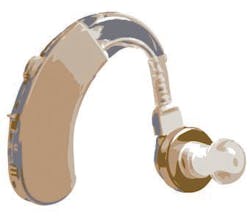Mobile-Phone Antenna Passes Hearing-Aid Tests
The researchers used a coupler-fed, on-board, printed inverted-F antenna with a bypass radiating strip. That strip was connected to the antenna's radiating portion to achieve wide upper and lower bands (covering 1710 to 2690 MHz and 698 to 960 MHz, respectively). As an added benefit, use of the radiating strip allowed the engineers to effectively smooth variations in the antenna's input impedanceespecially in the case of frequencies over the upper band.
The antenna was placed at the bottom edge of the mobile phone's system circuit board, where it was surrounded by an L-shaped ground plane. As a result of this approach, the excited surface currents on the main ground near the acoustic output can be greatly decreased. In fact, this ground-plane placement can bring about decreased near-field strengths of both the emitted electric and magnetic fields on the observation plane above the acoustic output.
The mobile phone with an embedded LTE/WWAN antenna qualifies as a hearing-aid-compatible wireless device, as the eight operating bands can have an HAC category rating of at least M3. The researchers also analyzed the effects of the user's hand holding the mobile phone on the performance of the antenna. See "Hearing Aid-Compatible Internal LTE/WWAN Bar-Type Mobile Phone Antenna," Microwave And Optical Technology Letters, April 2011, p. 774.
